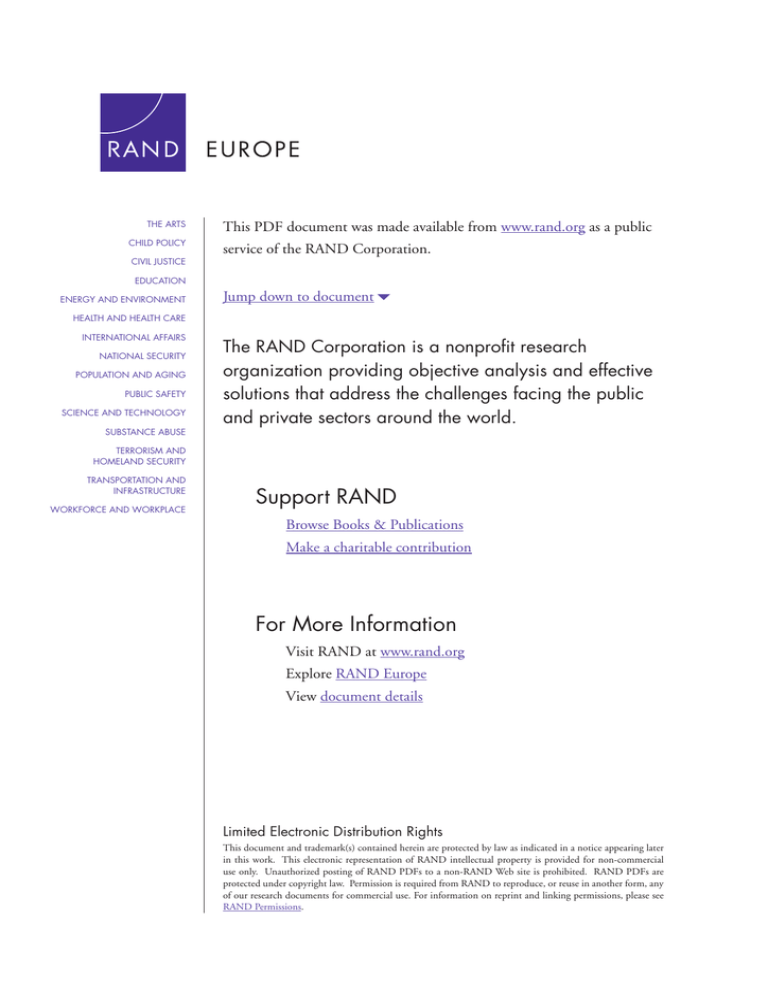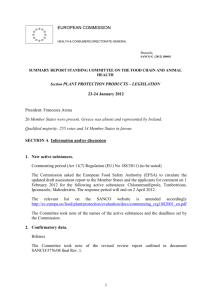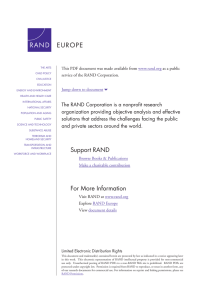
THE ARTS
CHILD POLICY
CIVIL JUSTICE
This PDF document was made available from www.rand.org as a public
service of the RAND Corporation.
EDUCATION
ENERGY AND ENVIRONMENT
Jump down to document6
HEALTH AND HEALTH CARE
INTERNATIONAL AFFAIRS
NATIONAL SECURITY
POPULATION AND AGING
PUBLIC SAFETY
SCIENCE AND TECHNOLOGY
SUBSTANCE ABUSE
The RAND Corporation is a nonprofit research
organization providing objective analysis and effective
solutions that address the challenges facing the public
and private sectors around the world.
TERRORISM AND
HOMELAND SECURITY
TRANSPORTATION AND
INFRASTRUCTURE
WORKFORCE AND WORKPLACE
Support RAND
Browse Books & Publications
Make a charitable contribution
For More Information
Visit RAND at www.rand.org
Explore RAND Europe
View document details
Limited Electronic Distribution Rights
This document and trademark(s) contained herein are protected by law as indicated in a notice appearing later
in this work. This electronic representation of RAND intellectual property is provided for non-commercial
use only. Unauthorized posting of RAND PDFs to a non-RAND Web site is prohibited. RAND PDFs are
protected under copyright law. Permission is required from RAND to reproduce, or reuse in another form, any
of our research documents for commercial use. For information on reprint and linking permissions, please see
RAND Permissions.
This product is part of the RAND Corporation technical report series. Reports may
include research findings on a specific topic that is limited in scope; present discussions of the methodology employed in research; provide literature reviews, survey
instruments, modeling exercises, guidelines for practitioners and research professionals, and supporting documentation; or deliver preliminary findings. All RAND
reports undergo rigorous peer review to ensure that they meet high standards for research quality and objectivity.
Evaluation of
DG SANCO data
management practices
Final report
Jan Tiessen, Claire Celia, Tom Ling, Helen Ridsdale,
Maiwënn Bareaud, Christian van Stolk
Prepared for the European Commission Directorate General for
Health and Consumers (DG SANCO)
EUROPE
The research described in this report was prepared for the European Commission. The
opinions expressed in this study are those of the authors and do not necessarily reflect the
views of the European Commission.
The RAND Corporation is a nonprofit research organization providing objective analysis
and effective solutions that address the challenges facing the public and private sectors
around the world. RAND’s publications do not necessarily reflect the opinions of its
research clients and sponsors.
R® is a registered trademark.
© Copyright 2010 European Commission
All rights reserved. No part of this book may be reproduced in any form by any electronic or
mechanical means (including photocopying, recording, or information storage and retrieval)
without permission in writing from the European Commission.
Published 2010 by the RAND Corporation
1776 Main Street, P.O. Box 2138, Santa Monica, CA 90407-2138
1200 South Hayes Street, Arlington, VA 22202-5050
4570 Fifth Avenue, Suite 600, Pittsburgh, PA 15213-2665
Westbrook Centre, Milton Road, Cambridge CB4 1YG, United Kingdom
RAND URL: http://www.rand.org
RAND Europe URL: http://www.rand.org/randeurope
To order RAND documents or to obtain additional information, contact
Distribution Services: Telephone: (310) 451-7002;
Fax: (310) 451-6915; Email: order@rand.org
Executive summary
This study assesses DG SANCO’s current data management practice
RAND Europe was asked by DG SANCO to assess the current data management practice
within DG SANCO. Data management in this definition comprises the use of data in
policy making in its wider meaning. This study maps current practice, identifies perceived
strength and weaknesses and develops recommendations to address them. The context of
this work is the desire of DG SANCO to develop a comprehensive data strategy to meet
the increasing needs of evidence-based policy making. Such a strategy would seek to
establish good practice in how data are identified, collected, stored, analysed, used and
communicated.
The findings of this report were based mostly on interviews with DG SANCO staff
The analysis contained in this report relies to a large extent on key informant interviews
and thus resembles a perception audit of what a subset of DG SANCO staff see as current
practice, its strengths and its weaknesses. In addition internal documentation obtained
from DG SANCO was reviewed, and the research team analysed a sample of documents
produced during the different stages of the policy process. This report focuses mostly on
areas of improvement, though it was clear from the interview findings that current practice
in DG SANCO had many strengths. Therefore, DG SANCO starts from a position of
strength in data management. In other areas more substantial changes are required, in the
opinion of staff.
DG SANCO’s current data practice is characterised by diversity between directorates and
policy stages
DG SANCO staff use a relatively wide definition of data, including not only quantitative
statistical data, but also more qualitative sources of data. The data needs between
directorates differ substantially in terms of type and content of data; in general there
appears to be little overlap in data needs between directorates, often even between units.
Both (perceived) data needs and actual use of data differ substantially between policy
stages. The impact assessment stage is currently the most data-heavy stage of the policy
process, using the widest range of data types and sources; while enforcement and
evaluation are the stages with the most comprehensive use of statistical information, often
collected by DG SANCO or submitted by Member States.
DG SANCO produces some of its own data, but in the early stages of the policy process it
mostly relies on the use of external data sources such as Eurostat, and the use of external
contractors is widespread. For enforcement purposes, however, DG SANCO mostly relies
xiii
Evaluation of DG SANCO Data Management Practices: Final report
RAND Europe
on self-generated data obtained through alert systems (e.g. RAPEX) or reporting
requirements for Member States.
DG SANCO has access to a substantial amount of data that it requests from Member
States, but these most of these data are deposited in a large number of different databases
or even not stored in an electronic format. Overall, data storage is decentralised and
fragmented. Data sharing and collaboration are taking place between colleagues at DG
SANCO informally but there is a lack of formal knowledge about what staff are doing
across units and directorates.
Data analysis tends to be descriptive and qualitative rather than statistical in nature,
assessing context and problems rather than evaluating and projecting. There is a lack of
quantitative data analysis and in-house specialist skills (i.e. those of economists and
statisticians) to deal with data outside the specialist units, which is partially compensated
for by the widespread use of contractors to analyse data.
DG SANCO staff currently conduct, for the most part, pragmatic assessments of the
quality of data they use. The two main means by which staff assess data quality are (1)
checking that the data source is reliable and (2) assessing the comparability of the data.
There are no formal guidelines on how to assess the quality of data.
Perceived strengths and weaknesses vary by directorate and function
The perception of current strengths and weaknesses in using data for policy making differs
between directorates and experience in data use, with staff from information units and
Directorates D, E and F the most positive about current strengths and weaknesses. This
points to pockets of good practice that should be extended to improve the overall
performance of DG SANCO. Key issues mentioned both as strengths and weaknesses
include the following:
In general, collaboration and knowledge sharing between individuals was
perceived as a strength and as working very well. There were, however, concerns
that this collaboration was personalised at an individual level, which could be a
barrier for new staff.
Specialist skills to collect, analyse and use data are perceived to be in short
supply at DG SANCO in general, but some units in Directorates D, E and F and
the information units (B1, C2) have substantial skills for and experience in using
quantitative data.
While staff working on enforcement and in the information units were generally
satisfied with the availability of data and consider it a strength, other respondents
highlighted problems in access to data and knowledge about potential data
sources.
Nevertheless, respondents also felt that some of the data available to DG SANCO
are not sufficiently used because staff are unaware of the existence of those data,
or because quality and comparability make them difficult to use.
Staff felt that there is the importance of data for DG SANCO is increasing, but
the use of data is still very much ad hoc and data do not yet play a sufficient role
in policy development;
xiv
RAND Europe
Executive Summary
The report includes strategic high-level and specific recommendations
High-level recommendations focus mostly on the shift in organisation and culture which
will be required for the development of a comprehensive data strategy. Therefore, they are
likely to represent changes that it may be difficult to implement and that require a long
time horizon to embed. They focus on the following.
1.
Clarify the purpose of a data strategy
Prior to developing a high-level data strategy, DG SANCO should define and clarify
the purpose of a data strategy and define what it wants data to be used for. Currently
a wide range of sometimes competing purposes is mentioned by DG SANCO staff,
ranging from monitoring enforcement action and implementation to communication
to the general public. If DG SANCO wants to cover a wider range of purposes, it
should make sure that the data strategy acknowledges the different uses for which data
are intended.
2.
Think ‘information’ and ‘knowledge’ rather than data
In developing a comprehensive data strategy, DG SANCO should think about the
knowledge and information it requires for policy making. Data will only become
useful when structured, interpreted and understood in context. Thus DG SANCO
should ensure that the capacity and skills to make use of data are available.
3.
Prioritise
Given the limited resources and skills available, it will be essential to prioritise the
collection of specific data. This prioritisation should be based on the key questions
that DG SANCO needs to answer – that is, the information and knowledge DG
SANCO wants to obtain. For example, one approach that can be used is logic
modelling, establishing a logic and theory of change.
4.
Create a decentralised, but coordinated, organisational structure system
Given the differences between directorates, both in term of subject area and type of
activity, DG SANCO should consider a decentralised, but coordinated, organisational
basis for its data strategy. This should be supplemented by shared resources for the
whole organisation, and regular communication between these units should take
place, including updates on their recent activities. Information units available should
be used to a greater extent and could form the core of directorate-wide centres of
expertise and support for policy units.
5.
Aim for cultural change
Any organisational and procedural change suggested here should be embedded in a
process of cultural change. DG SANCO staff should feel that using data in their dayto-day work is relevant, valued and recognised within the wider organisation.
Ultimately, DG SANCO staff will need to be aware that using data makes a
substantial difference in the policy process by improving decisions taken.
Specific recommendations
Specific recommendations are closely linked to the weaknesses identified by staff, and this
relationship is shown in Table 0.1 below.
xv
Evaluation of DG SANCO Data Management Practices: Final report
RAND Europe
Table 0.1.1: Linking recommendations to the issues identified
Weakness mentioned
Recommendation
Lack of specialist skills in-house
Produce a map of data management specific skills of DG
SANCO staff
Provide basic training on data use and management for DG
SANCO staff
Some of the data within DG SANCO are
either not used at all or not well used
Harmonisation issues with data obtained
from Member States
Current data management practices are
reactive and crisis driven
Access to data is sometimes an issue, as
well as how data are used
Policy is not sufficiently data led
Timeliness is an issue in data management
Problems with collaboration in data
collection and analysis
No unified approach to data across DG
SANCO
Establish a central survey unit
Conduct a data inventory
Create a central knowledge base or information hub on
available data sources, both internal and external
Develop methods to define data needs systematically
Develop basic guidance on the use of data in day-to-day
policy work
Develop guidance on how to assess and ensure data quality
Plan and discuss data needs as early as possible in the
policy making process.
Make data use more visible.
Be prepared for ad-hoc data needs.
Become more concise in contracting out research
Strengthen external collaboration on data collection
Create decentralised support structures
This report provides additional tools to implement a data strategy
The appendices to this report contain additional tools for DG SANCO to develop and
implement a comprehensive data strategy, including a reflection on how to develop the
high-level macroindicators that DG SANCO should use, some practical tips for staff, and
indicators to help understand the effectiveness of a data management strategy. For the
high-level indicators, the study proposes using a ‘theory of change’ approach, whereby DG
SANCO examines its logics of intervention or how it produces impacts. The indicators are
then developed on the basis of how DG SANCO achieves these impacts. In terms of
practical tips, the report identified a number of key diagnostic questions for use by DG
SANCO staff at each stage of the data management framework. These were identified on
the basis of the interviews and offer a checklist for staff to help them improve data
management. Finally, the impact of a data strategy has to be evaluated once changes have
been made. This requires DG SANCO to establish a baseline and then look ex-post at how
data management has become embedded and what its impact has been.
xvi







